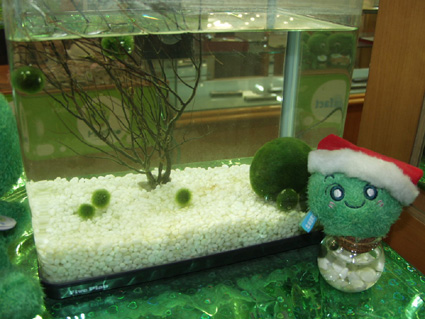
Legend has it, eventually this love blossomed into something so powerful, it transformed both woman and man into marimos.
A marimo is a plant that lives, as one might expect,at the bottom of Lake Akan, in Hokkaido, Japan. The first impression of this aquatic dweller is
something between curiosity and wonder.
It does not look like ordinary plants seen in flower shops,with roots fixed to the earth, leaves searching for the sunlight, flowers blooming. A marimo does not have leaves or flowers, and certainly does not have roots. The way it floats around in the water, here and there, often sinking down to the bottom of the bowl, it gives the odd feeling that it may be alive. It definitely does not resemble an animal. It can be more accurately described as a green fur ball, measuring one centimeter in diameter. Adiminutive wonder, one might say.
The fabled, curious little plant eventually made its way to more distant shores. "Marimos were brought over to Korea last November, and that was when I first saw them," recalls Kim Seung-tae, the president of "Raising a Marimo," http://cafe.daum.net/marimo a cyber cafe located on the Daum portal site. "I was just passing by, when I saw something inside a fish bowl, and was soon surprised to find out that it was a plant."
Marimos are grabbing the spotlight hundreds of kilometers away from home, but not as living proof of a love that defied all odds. These days they are something less symbolic and a lot more, well, meaningful. Marimos make great pets.
Pet-plants, that is. And one of the reasons for this is the ease of growth, suitable to an urban environment and requiring minimal resources and care. Changing the plant"s water once a week and making sure that it is not exposed to high temperatures and direct sunshine will do the trick.
The marimo uses photosynthesis to produce its energy needs. The light inside an apartment is plentiful for that purpose. Anything more, like exposure to direct sunshine, can harm the marimo, since its natural habitat is the semi-dark lake bottom. Give it a regular supply of fresh water, take care not to overexpose it to light and heat, and your exotic new pet-plant can live for a thousand years. Literally.
?
"At first I was worried whether I could raise it well or not. But now I dream to pass the marimo over to the next generation, and the next," says
Kim, who is only in his late twenties.
What price can be put on such a gift between generations? Well, considering that the marimo is smaller than a thumbnail, the price of 9,000 won may feel rather expensive. If decorations or ornaments are added, the price can increase. But if you consider the expiration date, it may not seem like college tuition fees after all.
Overpriced or not, the marimo is winning the hearts of teenage students and young couples. The cyber cafe, "Raising a marimo" sarted out in November 2002, but within half a year it managed to gain more than 3,600 members. Its members exchange information about the growth of their marimos, and share their experiences with their pet-plants-for-life.
"Marimos symbolize hope, love, and dreams. Many people seem to find joy in caring for their marimo," says Kang Yeo-Yeom, the manager of a marimo shop in Jongno. "These days, it is even regarded as a lucky charm. Maybe some day, the marimo will replace the fourleaf clover as the universal symbol for luck." What was the four-leaf clover story, anyway?
winstraight@ewha.ac.kr

